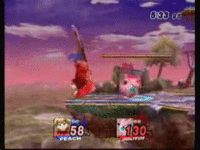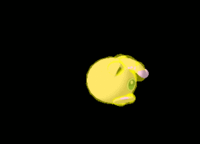Wall of pain: Difference between revisions
m (→Kirby) |
m (→Kirby) |
||
| Line 20: | Line 20: | ||
The technique returned in ''Brawl'', and as a result of Kirby's improved air speed in the game, the technique is arguably as powerful as Jigglypuff's Wall of Pain. | The technique returned in ''Brawl'', and as a result of Kirby's improved air speed in the game, the technique is arguably as powerful as Jigglypuff's Wall of Pain. | ||
Kirby is still capable of performing the wall of pain against larger opponents in Smash 4, sometimes being able to carry opponents entirely off-stage from 0 percent. | Kirby is still capable of performing the wall of pain against larger opponents in Smash 4 using his forward aerial, sometimes being able to carry opponents entirely off-stage from 0 percent. | ||
==={{SSBB|Meta Knight}}=== | ==={{SSBB|Meta Knight}}=== | ||
Revision as of 05:19, September 21, 2015

Wall of pain (abbreviated "WoP", also known by several other names, like Wall of Death) is a Jigglypuff technique which involves barraging the opponent with fast aerial attacks, exploiting Jigglypuff's high horizontal air speed to weave back and forth. The Wall of Pain can be used as either a method to juggle enemies offstage, as a powerful edgeguarding technique, or as a method to increase the damage on opponents. In all four games, the technique is among the most important in Jigglypuff's metagames, and proper use of it is important for use of Jigglypuff in tournaments.
Overview
On the ground, Jigglypuff should move forward in the air with each attack, then once the opponent is hit, move back to the place where the Wall of pain was started. This allows for quick attacks and keeps Jigglypuff out of range from any retaliations. In Super Smash Bros. Melee, this is done by interspacing Jigglypuff's back aerial with jumps while moving off the stage, utilizing Jigglypuff's superior air maneuverability to always land a hit with each spin kick.
In Brawl, the back aerial has lost its knockback, and the forward aerial has had its increased, which allows for an easier WoP, since Jigglypuff does not need to face backward. Therefore, when on the ground, or working up damage, the back aerial WoP is utilized to keep the forward aerial fresh, but for juggling off the stage at higher damage, the forward aerial, with greater knockback, works better. Stale-move negation means that switching between the two, if possible, has a greater effect. Pound can be incorporated into the WoP if used solely for working up damage.
In Smash 4 Jigglypuff's back aerial has much more knockback again and is designed as a finisher rather than a combo move, making it easier to finish a WoP with a back aerial but harder to keep one going. As such, most WoP's in Smash 4 generally utilize Jigglypuff's forward aerial (and neutral aerial as a finisher) instead.
Smashers Tetsuya and AOB were the earliest prominent users of the technique, and they are largely responsible for its widespread use. The term "wall of pain" was coined by SmashBoards administrator and retired smasher Amorasaki, a longtime friend of AOB.
Other characters
While other characters also have midair jumps, most do not have the appropriate recovery potential, air speed, or falling speed in order to fully emulate Jigglypuff's Wall of Pain. Wolf, Kirby, King Dedede, and Meta Knight, however, have techniques that potentially can act similar to the Wall of Pain. Some other characters, such as Captain Falcon in Melee, may have "pseudo-Wall of Pains" that do perform similar outcomes, however do not involve use of a back air or use other moves.
Kirby
In Melee, Kirby can use a similar technique to the Wall of Pain with his back air. Called the Fence of Pain, due to having more "holes" than Jigglypuff's Wall of Pain, the technique is arguably Kirby's most powerful in his otherwise weak Melee metagame.
The technique returned in Brawl, and as a result of Kirby's improved air speed in the game, the technique is arguably as powerful as Jigglypuff's Wall of Pain.
Kirby is still capable of performing the wall of pain against larger opponents in Smash 4 using his forward aerial, sometimes being able to carry opponents entirely off-stage from 0 percent.
Meta Knight
In Brawl, Meta Knight can potentially use his back or forward aerial attacks in order to perform a pseudo-Wall of Pain. The presence of the Sakurai angle in these attacks, however, prevents the attacks from consistently sending opponents in one expected direction, and Meta Knight's below average air speed hinders his ability to pursue opponents. His long, safe recovery, however, makes this Wall of Pain of rather low risk to perform.
King Dedede
In Brawl, King Dedede has his own wall of pain with his back air. It is arguably as useful as Jigglypuff's due to his back air's speed, lingering hitbox, short duration, and decent power. However, it can be difficult to continue chasing opponents with it due to his very fast falling speed and incredibly low air speed, however his low gravity, as well as his long, hard-to-intercept recovery can reduce the risk of performing a wall of pain.
Wolf
In Brawl, Wolf can use a wall of pain with his back air, which is often considered a useful strategy for Wolf due to his very high air speed, and his back air's speed, power, and range. However, his very poor recovery and fast falling speed make it very risky to perform.
